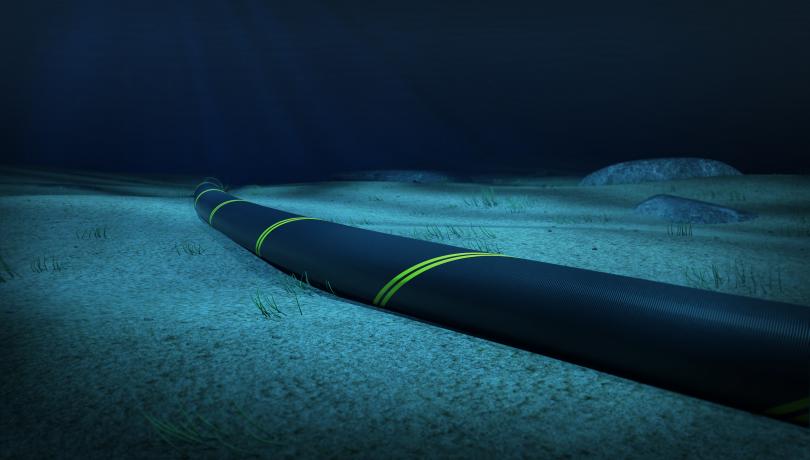The technology to be developed in the project has an important environmental dimension, since the continuous monitoring of the cable will also allow to detect earthquakes, submarine landslides, tsunamis and study the location and monitoring of marine mammals.

Submarine cables currently support 98% of international Internet traffic. We rely globally on this technology to communicate, conduct financial transactions and transmit information securely. Despite the fact that submarine cables are a very safe technology, it is extremely important to have effective maintenance systems to guarantee the functioning of the infrastructure and to solve any incident caused by natural and human phenomena (ship anchor knocks, for example).
Faced with this scenario, systems that ensure the protection and predictive maintenance of submarine cable infrastructures (PSI), such as the one developed by the public-private consortium formed by AFR-IX telecom, the University of Alcalá, the Institut de Ciències del Mar (ICM -CSIC) and Aragón Photonics are key to guarantee the transmission of data.
It is an intelligent monitoring system based on DAS (Distributed Acoustic Detection) technology, which allows to prevent cable damage by early warning of potentially harmful activities. At the same time, this system could have a direct application when it comes to subsea seismic measurements, as it allows converting submarine cables into large offshore seismic sensor arrays at minimal cost.
For its application, AFR-IX telecom will contribute its know-how in submarine cables. Specifically, it will facilitate the application of the system in its Medusa submarine cable and also the use of the Barcelona Cable Landing Station (an open port that is scheduled to come into operation in the first quarter of 2022) to store the data collected in real time.
For their part, the specialists from the University of Alcalá have world-renowned experience in DAS research, while the ICM-CSIC has experts in the development and implementation of seismological and oceanographic software. Finally, Aragón Photonics will provide its high-performance acoustic sensing equipment (HDAS), developed in collaboration with the University of Alcalá, and will create an infrastructure for monitoring and processing optical signals in a fiber that will make it possible to analyse how variations in the seabed environment – temperature and movement – are translated into variations of the same.
The project is funded by the Ministry of Science and Innovation (PSI Project with reference PLEC2021-007875) and the NextGenerationEU/PRTR program of the European Union, with a total of 1,446,136.92 euros.
A pioneering system based on DAS technology and artificial intelligence
The new monitoring system, based on DAS technology, has, on the one hand, a high-fidelity fiber interrogator (HDAS), a device that allows recording small deformation variations of optical signals along a fiber-optic cable; and, on the other hand, with an artificial intelligence system (AI) capable of analyzing the data collected by the HDAS and transforming it into an intelligent interpretation of the potential threat to the cable in all possible situations, as well as of environmental variations in the seabed.
This allows to continuously analyse natural and anthropogenic threats in the fiber-optic infrastructure and generate early warnings to be able to act in a preventive manner. In short, a completely innovative maintenance scheme in the field of submarine cable infrastructure.
"This system will increase the resilience of the communications network and significantly reduce the extremely high costs of repairs to submarine cables," says Norman Albi, CEO of AFR-IX telecom.
Another positive point of the system is that it uses a technology (DAS) that, as mentioned, allows underwater seismic measurements that will help to better understand phenomena such as tides, ocean currents or meteotsunamis, that is, tsunamis of meteorological origin. In fact, recently the same HDAS equipment used in the project has been monitoring the seismic movements of the Cumbre Vieja volcano on the island of La Palma.
Finally, DAS technology provides the opportunity to monitor marine ecosystems through the monitoring of groups such as cetaceans, which contributes to their protection and the conservation of the habitats in which they live.
Medusa and Barcelona CLS, key elements of the project
To apply the technology of the pioneering monitoring system, AFR-IX will facilitate the use of its future submarine cable Medusa Submarine Cable System, a cable that will link 9 Mediterranean countries and that will come into operation in 2024.
Specifically, for the development of the intelligent monitoring system, access will be given to the Medusa submarine cable from the cable's landing stations in Barcelona (Barcelona Cable Landing Station -CLS-, promoted by AFR-IX), Torreguadiaro and Zahara de los Atunes, and other possible landings in countries of the European community.
From each landing station, a high-speed network will be provided through high-capacity routers and the Medusa submarine cable system network so that real-time DAS data can be transported to Barcelona CLS, where it will be processed by the University of Alcala. The 24/7 Network Operation Center team will guarantee the operation and security of the network, at the cable station sites and in Barcelona CLS so that the data can be analyzed at all times.